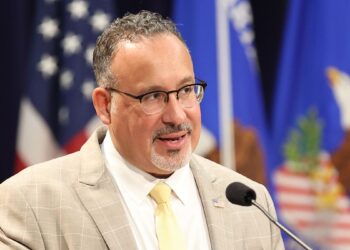Federal and state officials—as well as teachers unions—should be held accountable for the consequences of school closures, lawmakers on the House Select Subcommittee on the Coronavirus Pandemic said Tuesday.
“Long-term closing of schools proved to be harmful for students—their academic, mental, and social development, and overall success,” Chairman Brad Wenstrup, R-Ohio, said. “We need to make every effort to not let this happen again for the sake of our future.”
In a March 8 hearing, the subcommittee probed the origin of COVID-19 in China.
The hearing held Tuesday by this subcommittee of the House Oversight and Accountability Committee peered into several aspects of the pandemic, including evidence ignored by public health officials, how COVID-19 aid dollars were spent, and how other countries addressed the public health crisis.
Here are five key takeaways from the hearing.
1. Masks, Social Distancing Not ‘Science Based’
Both masking and social distancing policies for schools weren’t based in science, Dr. Tracy Hoeg, an epidemiologist in the University of California-San Francisco’s department of epidemiology and biostatistics, told the subcommittee.
“Were those necessary to keep schools open?” Rep. James Comer, R-Ky., chairman of the full House Oversight and Accountability Committee, asked.
“We had evidence prior to the pandemic that masks were largely ineffective at preventing community transmission of influenza and other upper-respiratory viruses,” Hoeg replied. “We did not obtain any new, high quality evidence in the COVID-19 pandemic that masks were effective strategy in schools or outside of schools.”
Comer followed by asking: “The mask guidance was not scientifically sound?”
“Correct. It wasn’t science based and the 6 feet of distancing was arbitrary. That was based on basically just looking at how far certain size droplets spread,” Hoeg replied, adding:
We ended up getting some pretty good observational data not finding correlation between 6 feet and 3 feet [of] distance and [COVID-19] case rates in schools. It wasn’t evidence based. It wasn’t necessary and wasn’t evidence based. We should have, by default, been keeping our schools open. Instead, we were requiring these non-evidence-based mitigation measures [and] strategies as a prerequisite for getting our children back in school. That’s a very harmful prerequisite.
2. COVID-19 Relief Goes to DEI, Anti-Racism Training
Rep. Nicole Malliotakis, R-N.Y., questioned the total expenses of COVID-19 aid that was intended to help schools reopen in a healthy way.
Instead, this money was diverted for other reasons, Malliotakis said, specifically calling out New York Gov. Kathy Hochul, a Democrat.
“Instead of using that funding for its original intent, we see states like New York spending it on all sorts of stuff,” Malliotakis said, adding:
New York City allocated $12 million to go for a restorative justice program. They did implicit bias, anti-racism training. New York State Ed [the New York State Education Department] decided to put more money into diversity, equity, and inclusion programs. I don’t know what that stuff has to do with COVID.
Malliotakis also pointed to money allocated for other specific purposes that is going elsewhere.
“The inflationary American Rescue Plan, which the Democrats passed in 2021 with their one-party rule, was billed as a necessity for reopening schools after the COVID pandemic,” Malliotakis said. “They decided to spend this money despite $1 trillion sitting there unused from the previous packages. This provided another $122 billion for elementary and secondary schools. It was so critical. They needed this money. They couldn’t open the schools without it. Guess what? As of November, only 15% of that money has been spent.”
3. What Experts Would Tell CDC and Teachers Unions
Rep. Marjorie Taylor Greene, R-Ga., said she wished that Randi Weingarten, president of the American Federation of Teachers, was answering questions from the panel.
Greene said she would like to hear from Dr. Rochelle Walensky, director of the Centers for Disease Control and Prevention.
“I’d also like to point out how the teachers union—who by the way were getting paid to stay home and didn’t have to go to work—were the ones talking to the CDC about ‘When should schools open?’” Greene said.
The Georgia Republican asked each witness what he would say to Weingarten or Walensky if given the opportunity.
“I would ask Dr. Walensky why the evidence that existed in front of us, the real world observational evidence, was dismissed or ignored and instead we focused on projections and models about what would happen,” testified David Zweig, a journalist who writes for The Atlantic, New York Magazine, and The Free Press and the author of a forthcoming book on school lockdowns called “An Abundance of Caution.”
Hoeg said she had questions for both Walenksy and Weingarten.
“I would like to discuss with Randi Weingarten both the perceived risk to teachers and children, as I think there was a misunderstanding and a miscalculation about the many risks that our children face and also the risk that our teachers face from children,” Hoeg said.
“I would like to ask Dr. Walensky why, when she was issuing guidance for reopening schools in 2021, she was using the wording of the teachers unions in terms of requiring 6 feet of distance and not actually consulting the scientists and physicians that were doing the actual research looking at the distance and transmission in schools,” the epidemiologist added.
Virginia Gentles, director of the Education Freedom Center of the Independent Women’s Forum, directed her questions at the head of the American Federation of Teachers.
“If I had the opportunity to speak with Randi Weingarten, I’d ask her about what her conversations are like with teachers in urban districts that were closed and did not serve students,” Gentles said. “What is it like to talk to teachers in Baltimore in schools that have zero percent students proficient? What is it like to talk to students in Newark who have less than 2% proficiency in math?”
Everyone should look at taking a preventive approach, said Donna Mazyck, executive director of the National Association of School Nurses.
“From the federal, state, and local level, ask for a way to communicate lessons learned; after-action plans are very common in dealing with emergencies,” Mazyck said. “That needs to happen on all levels so that we know what to do the next time we have a pandemic.”
4. Increase in Abuse, Depression
Wenstrup, chairman of the subcommittee, said each state and school district should have asked how to keep schools open.
“In the case of the COVID-19 pandemic, the lingering effects have been many—academic, mental, economic,” Wenstrup said. “There are also secondary harms from school closures that fell upon children. For example, abuse [and] poor nutrition [were] among them. We must strive to never let this happen again. Our children among us have paid the price and are continuing to pay the price.”
Zweig, during his opening remarks, said the school lockdowns had dire consequences.
“Educators represent around 20% of all official reports of child abuse or neglect. When kids were prevented from attending school, teachers were no longer able to act as a safety net for children being abused. Reports from New York to Chicago to California saw massive drops in reports of abuse,” Zweig said.
Rosado said depression and anxiety increased during the pandemic. He cited data from the Centers for Disease Control and Prevention that shows body mass index—a measure of body fat based on height and weight—almost doubled compared to a pre-pandemic period for children in grades K-12.
Meanwhile, researchers from Johns Hopkins and Columbia universities found that from December 2020 through April 2021, “screen time” for kids ages 4 to 12 increased by about 50% compared to pre-pandemic levels.
5. What About Europe?
Most European countries kept their schools open and didn’t see an upsurge in problems for youth, Hoeg noted during her opening remarks.
“Unlike Europe, virtually all 55 million K-12 students in the U.S. remained out of school in the spring of 2020,” the epidemiologist said, adding:
In July of 2020, the CDC released a document supporting the reopening of schools; though this document has been removed from the CDC’s website, I retained a quote and the original link. Before fall of 2020, however, the CDC set reopening metrics based on community transmission and test positivity rates, without citing evidence behind them. These guidelines put about 90% of the country in a category considered ‘high risk’ for reopening schools [in] early fall of 2020. Initial data from Europe and elsewhere had shown in-school transmission to be limited and community case rates to be unrelated to opening or closing of schools.
Rep. Kweisi Mfume, D-Md., later griped about the cited comparisons to most European countries that didn’t close schools during the pandemic.
“All the evidence we have now, we did not have at the time of COVID,” Mfume said. “It was a learning process that we were all going through.”
The Maryland Democrat added:
I would also caution against always comparing what we did in the U.S. against what they did in Europe to suggest that somehow or another, it should have been the same. The United States is one country. Europe is 44 nations. So let’s be real careful about how we compare apples to apples and oranges to oranges, and make sure we are talking about the same thing here.
But Zweig, the journalist and author, said it is an entirely appropriate comparison.
“Those are human beings. They are children,” Zweig said. “I’ve lived in Europe. They have very crowded cities. They do not have sophisticated HVAC systems in all their schools.”
He added:
That is real evidence in front of us. We are talking about the difference between looking at models and looking at projections over data, looking at theory over what we actually are observing.
We had actual, real world evidence from schools in countries throughout Europe with cities with very similar demographics to our cities. The class sizes were not three kids in a giant room. That evidence, for complex reasons, was disregarded.
Have an opinion about this article? To sound off, please email letters@DailySignal.com and we’ll consider publishing your edited remarks in our regular “We Hear You” feature. Remember to include the url or headline of the article plus your name and town and/or state
The post 5 Takeaways From House Hearing on COVID-19 School Lockdowns appeared first on The Daily Signal.
Federal and state officials—as well as teachers unions—should be held accountable for the consequences of school closures, lawmakers on the House Select Subcommittee on the… Read More
The post 5 Takeaways From House Hearing on COVID-19 School Lockdowns appeared first on The Daily Signal.











